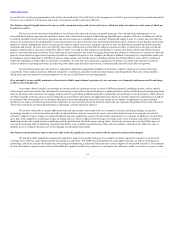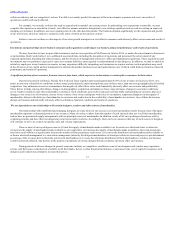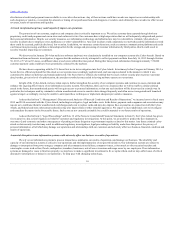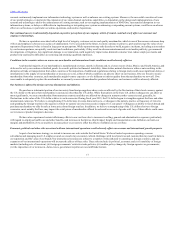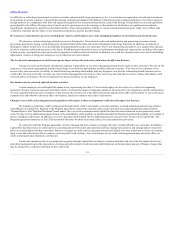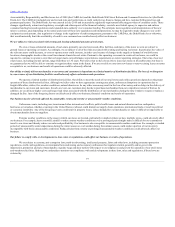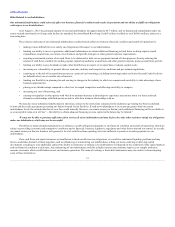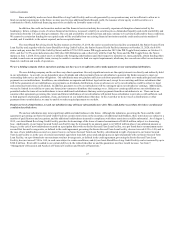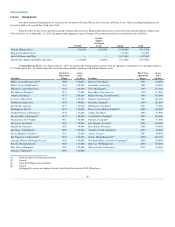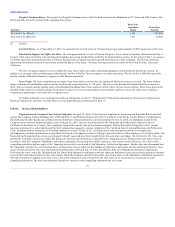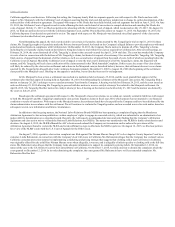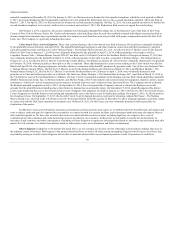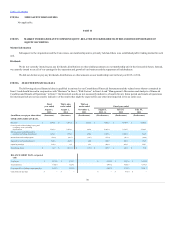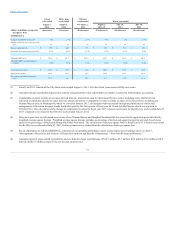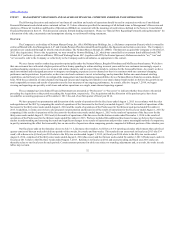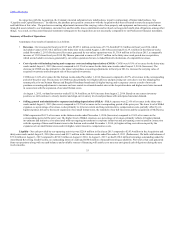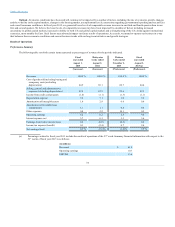Neiman Marcus 2014 Annual Report Download - page 25
Download and view the complete annual report
Please find page 25 of the 2014 Neiman Marcus annual report below. You can navigate through the pages in the report by either clicking on the pages listed below, or by using the keyword search tool below to find specific information within the annual report.
Table of Contents
The amount of borrowings permitted under our Asset-Based Revolving Credit Facility may fluctuate significantly, which may adversely affect our
liquidity, results of operations and financial position.
The amount of borrowings permitted at any time under our Asset-Based Revolving Credit Facility is limited to a periodic borrowing base valuation
of our accounts receivable and domestic inventory. As a result, our access to credit under our Asset-Based Revolving Credit Facility is potentially subject to
significant fluctuations depending on the value of the borrowing base eligible assets as of any measurement date, as well as certain discretionary rights of the
administrative agent of our Asset-Based Revolving Credit Facility in respect of the calculation of such borrowing base value. Our inability to borrow under
or the early termination of our Asset-Based Revolving Credit Facility may adversely affect our liquidity, results of operations and financial position.
We may elect to pay interest on the PIK Toggle Notes in the form of PIK Interest or partial PIK Interest rather than in the form of Cash Interest.
In the future, we may elect to pay either 50% or all of the interest due on the PIK Toggle Notes for such period in PIK Interest (as defined below) by
either increasing the principal amount of the outstanding PIK Toggle Notes or by issuing new PIK Toggle Notes for the entire amount of the interest payment,
thereby increasing the aggregate principal amount of the PIK Toggle Notes. We may elect to pay interest in the form of PIK Interest or partial PIK Interest on
up to six interest payments in the aggregate on any interest payment date in respect of the third interest payment in April 2015 (which was paid in cash)
through the tenth interest payment in October 2018. If we make such future interest payments in the form of PIK Interest or partial PIK Interest, the principal
amount of the outstanding PIK Toggle Notes would be increased, which in turn would further increase our substantial indebtedness. See “—Risks Related to
our Indebtedness—Our substantial indebtedness could adversely affect our business, financial condition and results of operations and our ability to fulfill our
obligations with respect to such indebtedness.”
Our variable rate indebtedness subjects us to interest rate risk, which could cause our debt service obligations to increase significantly.
Borrowings under our Senior Secured Credit Facilities are at variable rates of interest and expose us to interest rate risk. We have historically hedged
against interest rate fluctuations by using standard hedging instruments, but we are not required to do so and may not do so in the future. Interest rates are
currently at historically low levels. If interest rates increase and we are unable to effectively hedge our interest rate risk, our debt service obligations on the
variable rate indebtedness will increase even though the amount borrowed may remain the same, and our net earnings and cash flows, including cash
available for servicing our indebtedness, will correspondingly decrease. Assuming all revolving loans are fully drawn (and to the extent that LIBOR is in
excess of the 1.00% floor rate with respect to our Senior Secured Term Loan Facility), each quarter point change in interest rates would result in a
$9.5 million change in annual interest expense on the indebtedness under our Senior Secured Credit Facilities. In the future, we may enter into interest rate
swaps that involve the exchange of floating for fixed rate interest payments to reduce interest rate volatility. However, it is possible that we will not maintain
interest rate swaps with respect to any of our variable rate indebtedness. Alternatively, any swaps we enter into may not fully or effectively mitigate our
interest rate risk.
A lowering or withdrawal of the ratings assigned to our debt securities by rating agencies may increase our future borrowing costs and reduce our access
to capital.
Our indebtedness currently has a non-investment grade rating, and any rating assigned could be lowered or withdrawn entirely by a rating agency if,
in that rating agency’s judgment, future circumstances relating to the basis of the rating, such as adverse changes in our business, warrant. Any downgrade by
any ratings agency may increase the interest rate on our Senior Secured Credit Facilities or result in higher borrowing costs. Any future lowering of our
ratings likely would make it more difficult or more expensive for us to obtain additional debt financing.
We are controlled by the Sponsors, whose interests as equity holders may conflict with those of the lenders under our Senior Secured Credit Facilities and
the holders of the Notes.
We are controlled by the Sponsors. The Sponsors control the election of a majority of our directors and thereby have the power to control our affairs
and policies, including the appointment of management, the issuance of additional stock and the declaration and payment of dividends. The Sponsors do
not have any liability for any obligations under our indebtedness and their interests may be in conflict with those of the lenders under our Senior Secured
Credit Facilities and the holders of the Notes. For example, if we encounter financial difficulties or are unable to pay our debts as they mature, the Sponsors
may pursue strategies that favor equity investors over debt investors. In addition, our equity holders may have an interest in
24


